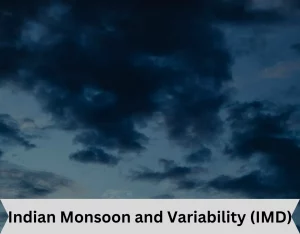ForumIAS announcing GS Foundation Program for UPSC CSE 2025-26 from 19 April. Click Here for more information.
ForumIAS Answer Writing Focus Group (AWFG) for Mains 2024 commencing from 24th June 2024. The Entrance Test for the program will be held on 28th April 2024 at 9 AM. To know more about the program visit: https://forumias.com/blog/awfg2024
Source: This post on the Variability of Indian Monsoon has been created based on the article “Gearing up for change” published in “The Hindu” on 20th January 2024.
UPSC Syllabus Topic: GS Paper 1 Geography – Important Geophysical phenomena.
News: The article discusses the findings of IMD’s data at the sub-divisional (tehsil) level on monsoon trends.
A detailed article on the Indian Meteorological Department (IMD) can be read here.
Indian Monsoon and Variability (IMD), In the150 years of its existence, the IMD has collected immense amounts of meteorological data that underlie its forecasts of the monsoon.
What IMD’s Data Mentioned on Monsoon Trends?
In an analysis of monsoon trends at the sub-divisional (tehsil) level, from 1982-2022, the following was noticed:
- Increase in Rainfall: Monsoon rainfall is increasing in more than half, or 55%, of India’s roughly 4,400 tehsils.
- Decline in Rainfall: About 11% of them saw decreasing rainfall. In those tehsils, 87% showed a decline during June and July, which are crucial for the sowing of kharif crops.
- Abnormally High or Low Rainfall: 30% of India’s districts witnessed several years of deficient rainfall years and 38% districts witnessed several years of excessive rainfall.
- Reversal of Rainfall Patterns: Some tehsils in Rajasthan, Gujarat, Maharashtra, and Tamil Nadu, that were historically dry, were getting wetter.
- Changes in North-East Monsoon: The northeast monsoon rain has increased by more than 10% in the past decade (2012-2022) in several tehsils in Tamil Nadu, Telangana, and Andhra Pradesh.
Here Are More Topics For Your Interest-
The problem with India’s science management
Nagara style of temple architecture
How Should These Findings be Utilised?
There is still research happening on whether Indian monsoon’s long dry spells followed by torrential wet spells can be attributed to natural variability or global warming. In this regard, prioritising regional and sub-district forecast data over national level data would be helpful.
This will help in making region-specific plans to improve climate resilience and channel necessary funds and resources.
Question for practice:
Why is localised data (at the sub-divisional (tehsil) level) regarding Indian monsoon more useful, compared to natinal-level data?





